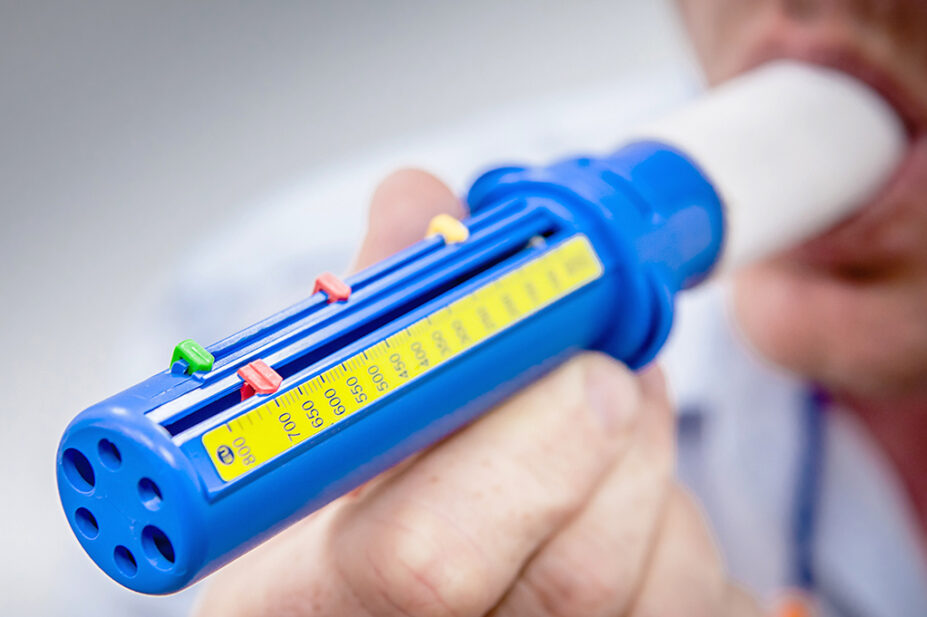
Shutterstock.com
Patients with suspected asthma or chronic obstructive pulmonary disease (COPD) in north Wales are currently unable to access timely high-quality diagnostics, leading to high cost and inappropriate prescribing of medication, including inhaled corticosteroids. Long-term treatment with corticosteroids risks exposing patients to adverse effects including osteoporosis and fractures, placing a further burden on acute services. In addition, patients not started on appropriate treatment are more likely to suffer exacerbations of their airway disease and be admitted to hospital.
What is the community diagnostic respiratory hub?
As a result, a community hub for improved diagnostic assessment and management of adult patients with COPD and asthma is being trialled in South Denbighshire, north Wales.
The hub receives referrals from eight GP practices and only takes new referrals for diagnosis. It does not provide spirometry for those already established on treatment. The hub operates one weekly afternoon session allowing a maximum of seven patients to be seen, four new referrals for lung function testing and three follow-up appointments.
The prescribing and follow-up are undertaken in the same clinic by a respiratory pharmacist prescriber and respiratory consultants take care of clinical oversight at Ysbyty Glan Clwyd.
New patients are first seen by the respiratory physiologist, who undertakes diagnostic testing at the hub. They use the primary care referral letter to review and update the patient history. Patients then complete spirometry +/- reversibility and fractional exhaled nitric oxide (FeNO) tests. Following this, they are reviewed by the respiratory pharmacist prescriber. The majority of the ‘query asthma’ patients will be asked to complete a peak flow diary for at least two weeks before returning to the hub for a follow-up appointment.
Smoking cessation, healthy eating, weight management, exercise and activity are just as important as inhaler treatment to preserve lung function in COPD
Some of the returning patients may be asked to complete a hypereactivity ‘challenge’ test to confirm a diagnosis of asthma, which typically takes place within three weeks. On average, patients referred to the hub require two appointments.
The respiratory hub was due to run for 12 months from October 2023 and feedback from patients so far has been overwhelmingly positive. Data are being collected for publication at the end of the pilot period regarding patient clinical outcomes and satisfaction with the service provided.
Access to the hub enables accurate diagnosis for patients with asthma and COPD, and improved compliance with National Institute for Health and Care Excellence and All-Wales guidelines and treatment recommendations.
The pharmacist’s role
Diagnosing asthma is not straightforward and requires careful reference to the patient history, spirometry +/- reversibility, FeNO, peak flow diary (variability), challenge test and any response to a trial of treatment to confirm diagnosis. As a respiratory pharmacist prescriber, I work collaboratively with the respiratory physiologist, reviewing the patient history and results from lung function tests to confirm or not, a diagnosis of asthma or COPD.
I commence newly diagnosed asthma patients with treatment following the All-Wales Asthma Guidelines 2024. The majority of these patients start maintenance and reliever therapy (MART) using dry powder inhalers. Inspiratory flow and inhaler technique is assessed using whistle testers and placebo devices. Patients are fully counselled on their new therapy and receive a completed asthma action plan. I explain how to use their peak flow meter and monitor the number of extra ‘when required’ reliever doses to enable better condition management.
COPD diagnoses are more straightforward with emphasis on the patient history, obstructive spirometry, nil or little reversibility or variability. Newly diagnosed COPD patients are started on treatment following the All-Wales COPD Guidelines and recommendations from Global Initiative for Chronic Obstructive Lung Disease (GOLD) 2023. Prescribed inhaled therapy is either dual bronchodilator or triple therapy (dual bronchodilator plus inhaled corticosteroid) for those patients with a history of exacerbation or asthma-like symptoms (eosinophilia or reversible spirometry). Inspiratory flow and inhaler technique are checked, and patients fully counselled on their new treatment. Almost all prescriptions completed are for dry powder inhaler devices.
I emphasise to the patient that inhaler treatment is only a small part of COPD management. Smoking cessation, healthy eating, weight management, exercise and activity are just as important to preserve lung function. Patients can also be referred for pulmonary rehabilitation from the respiratory hub.
Once a patient has completed their investigations, I write a detailed report to the referring clinician. The report includes the results of completed diagnostic tests and a plan of the ongoing treatment. I ask that patients newly diagnosed with asthma or COPD are followed up in surgery within three months. Patients with no clear diagnosis are referred back to their GP. On the advice of the respiratory consultant, some patients have been recommended a secondary care referral.
However, it is hoped that access to the respiratory hub will reduce the number of acute respiratory A+E attendances, out of hours/GP contacts and referrals for secondary care services. The hub should also provide onward referral to evidence-based interventions, such as stop smoking and pulmonary rehabilitation services.


